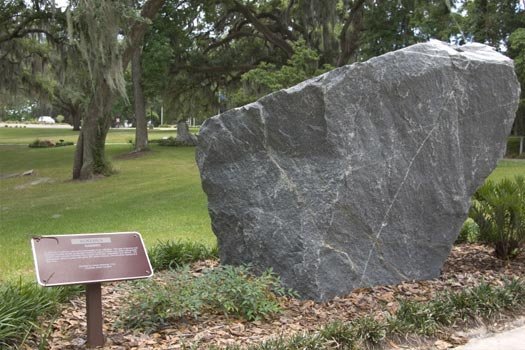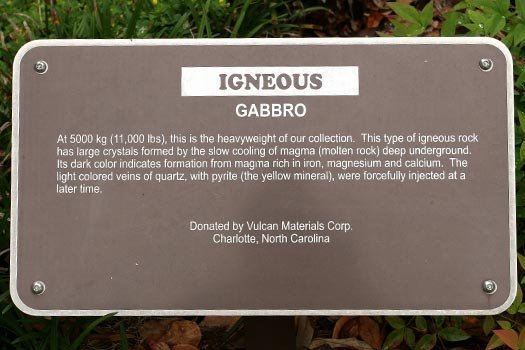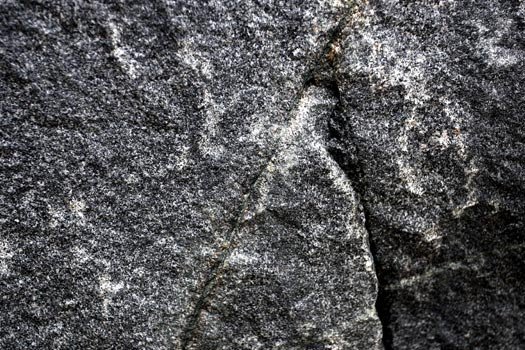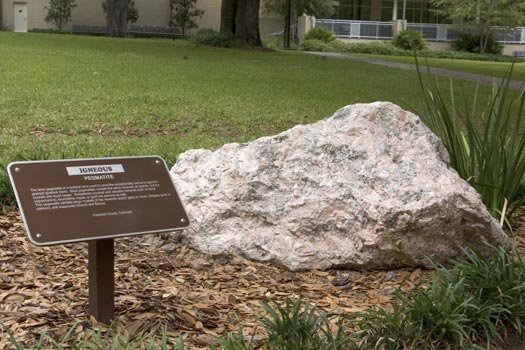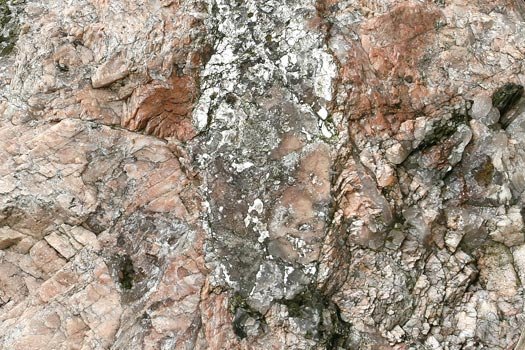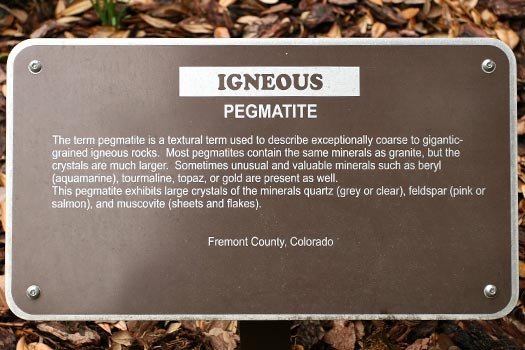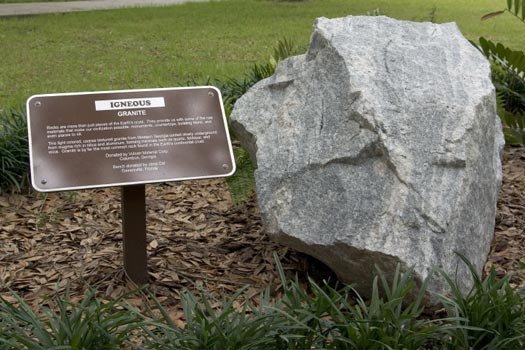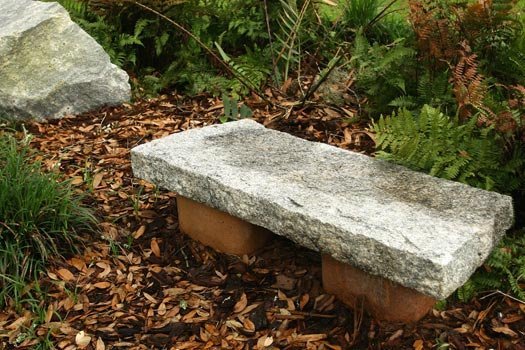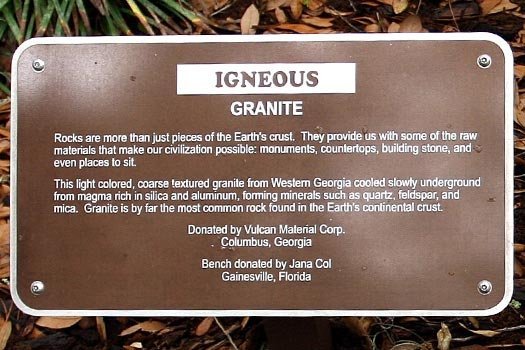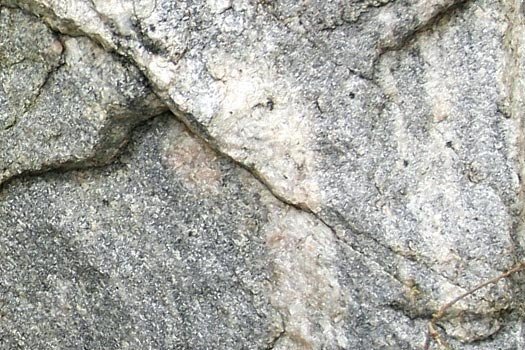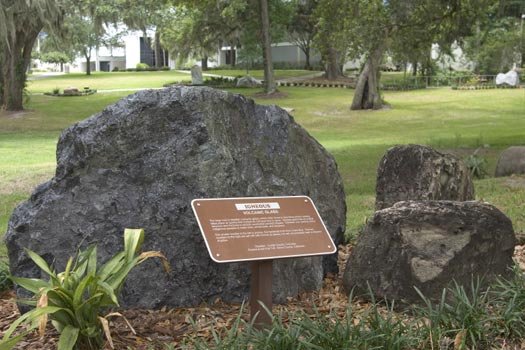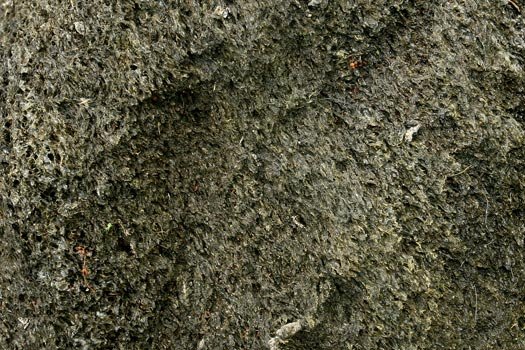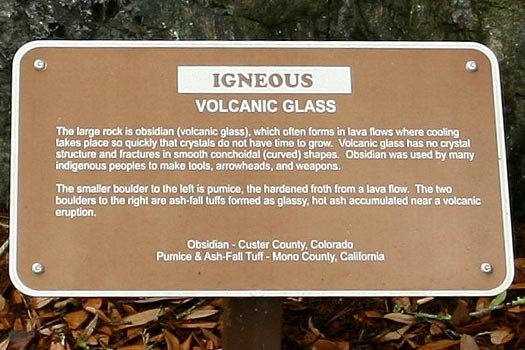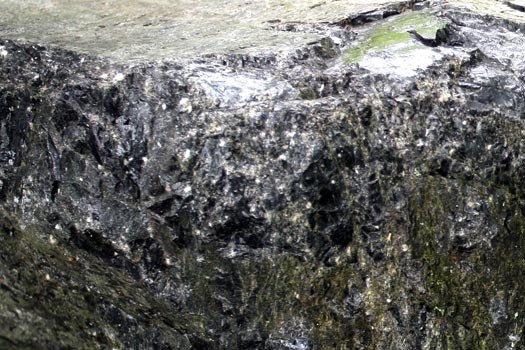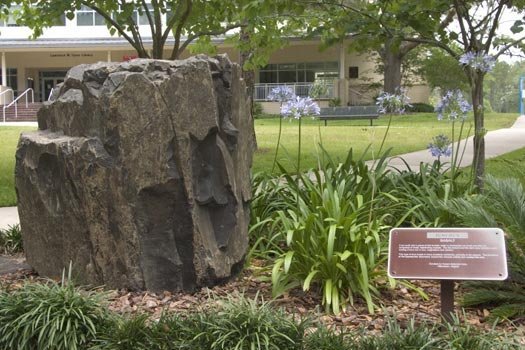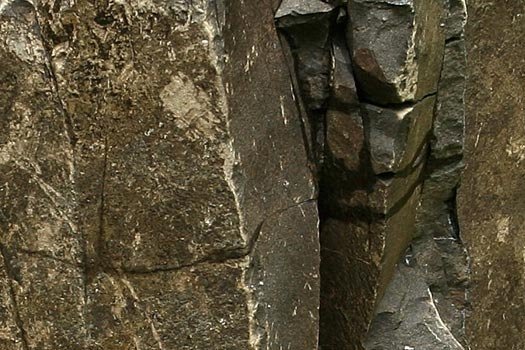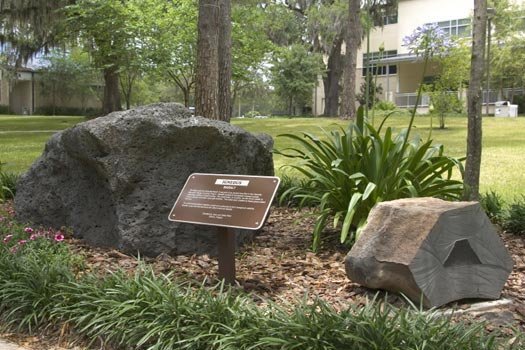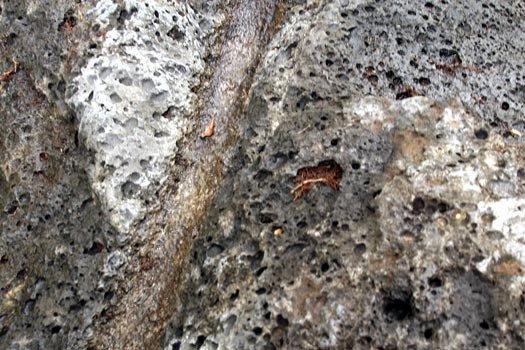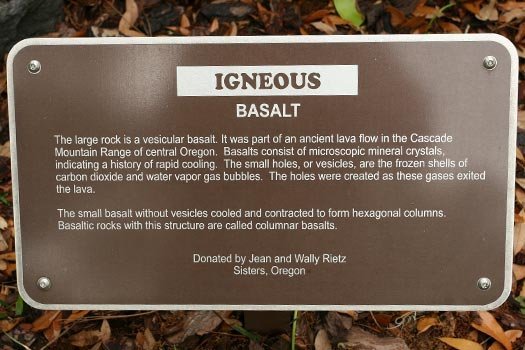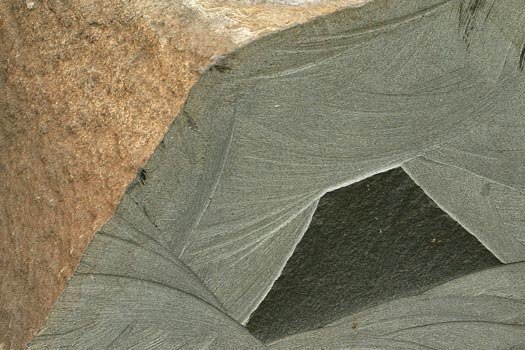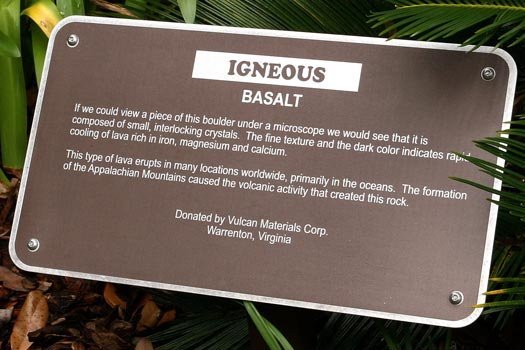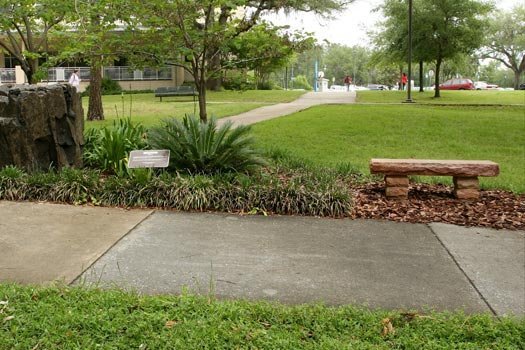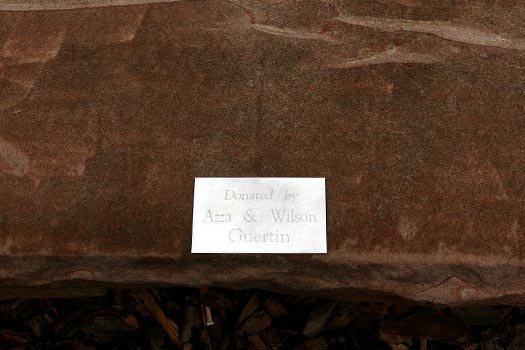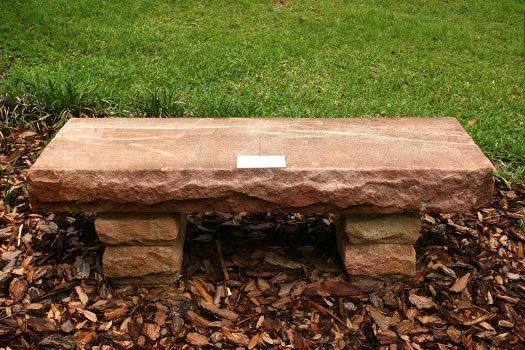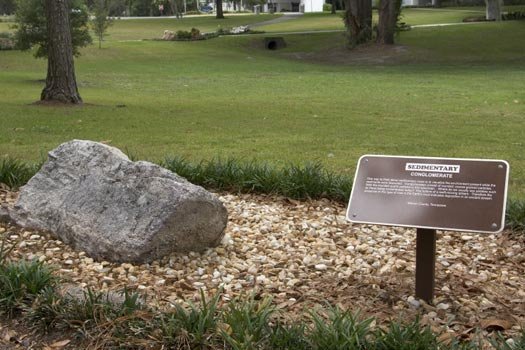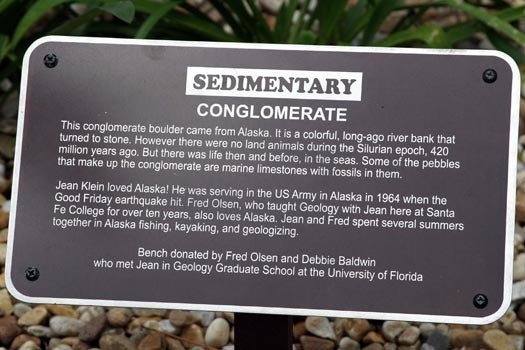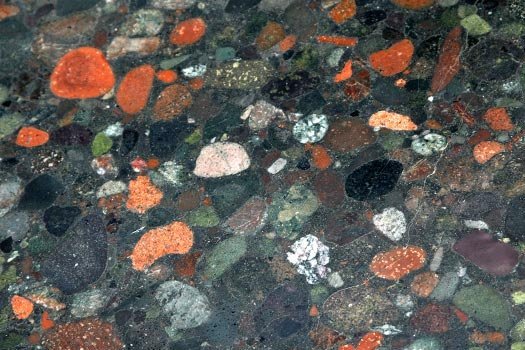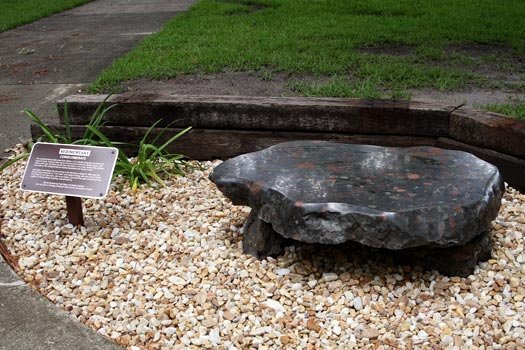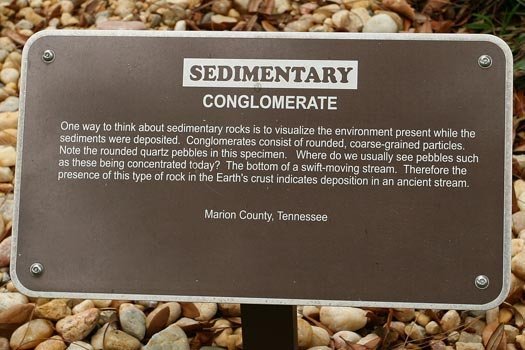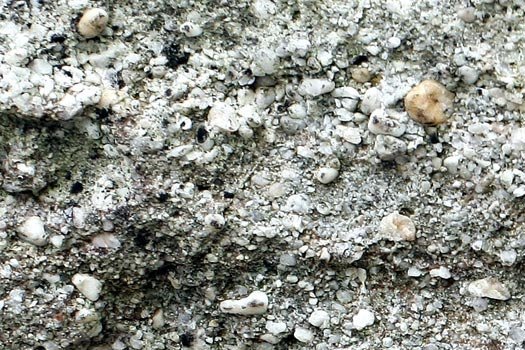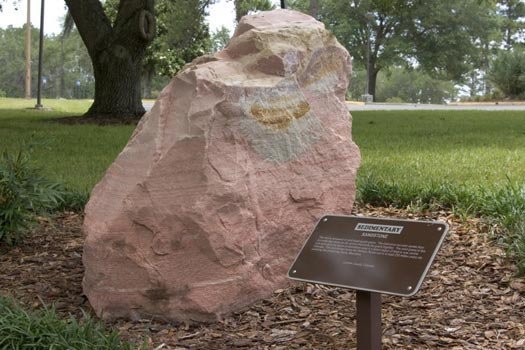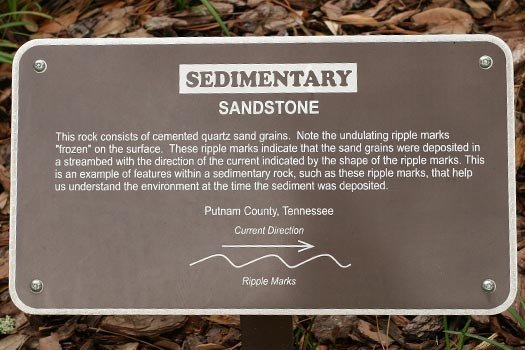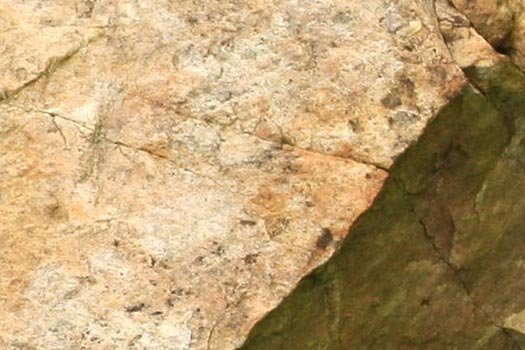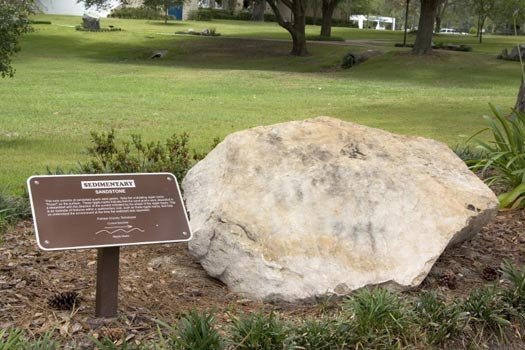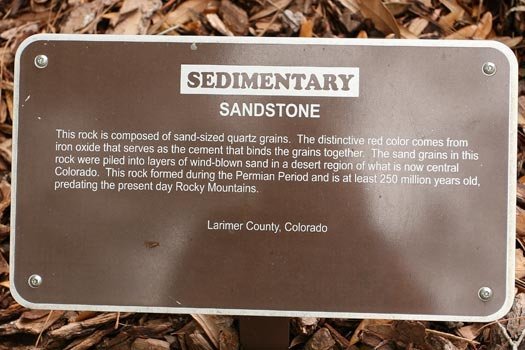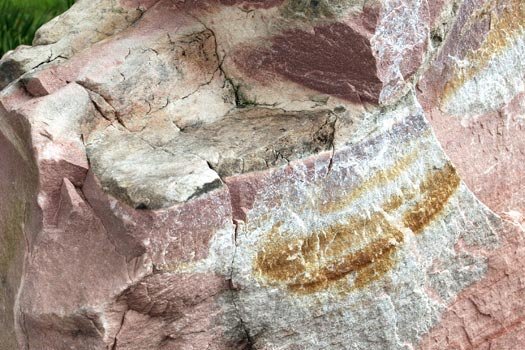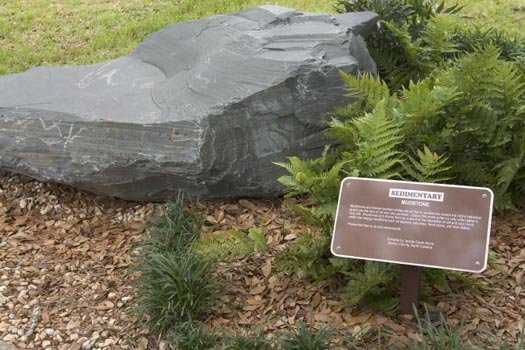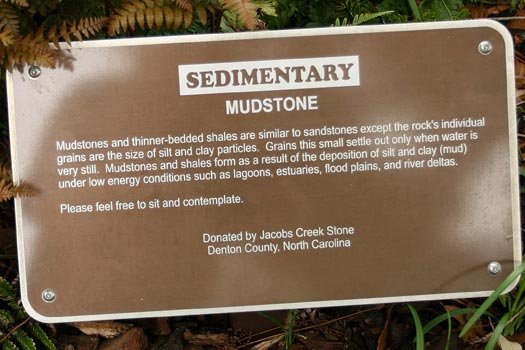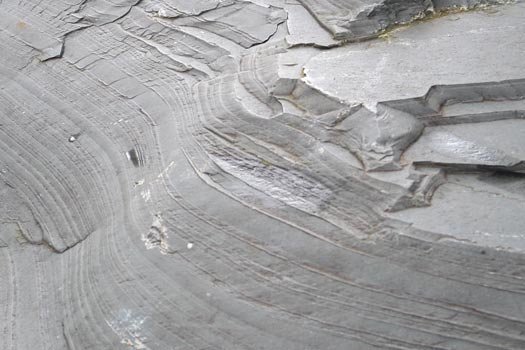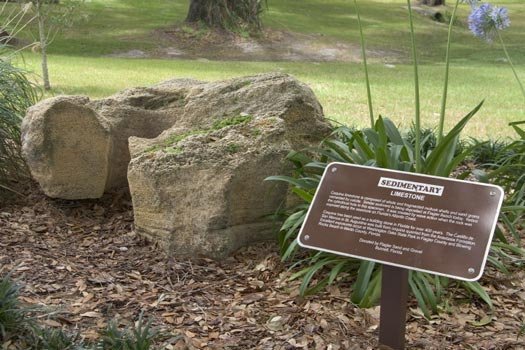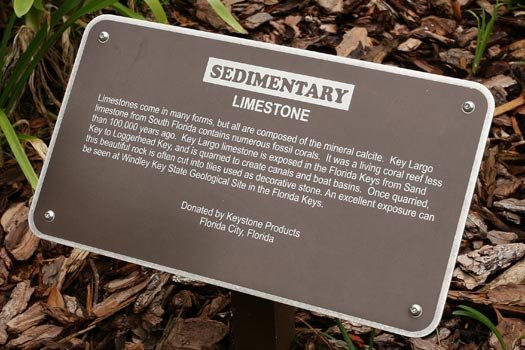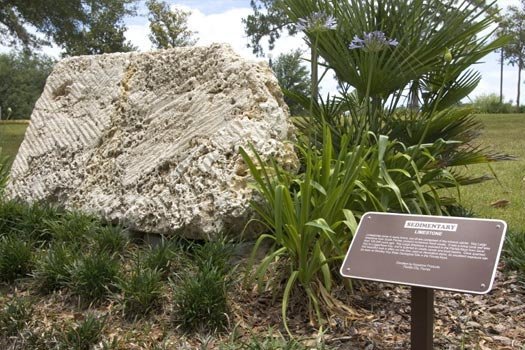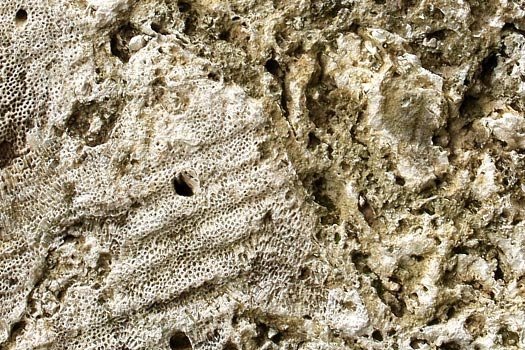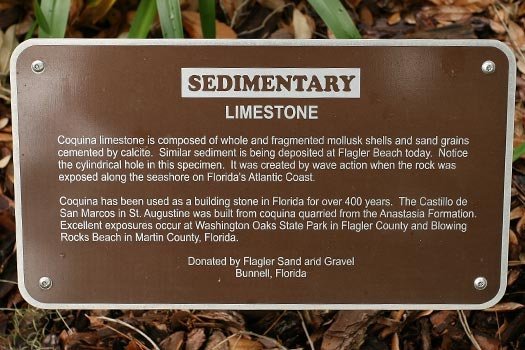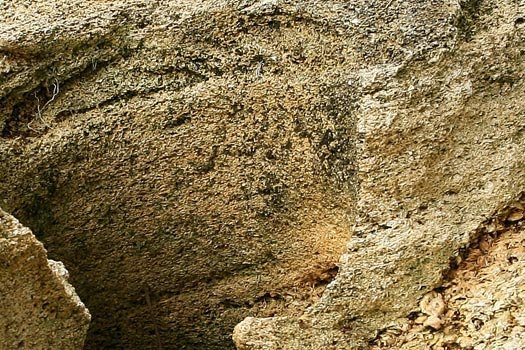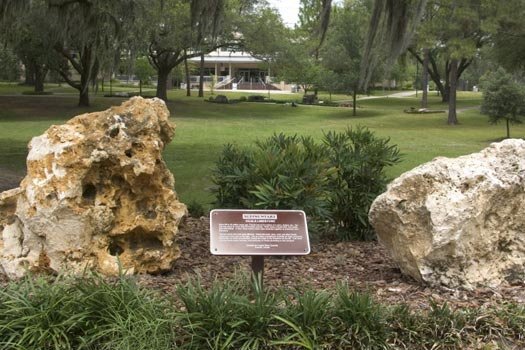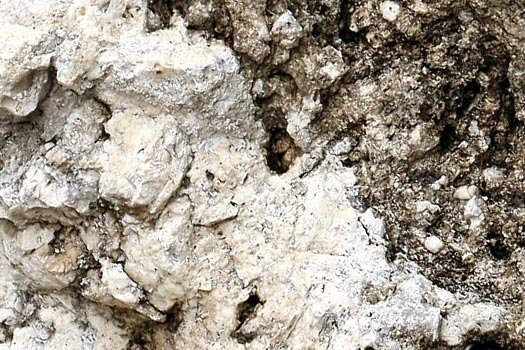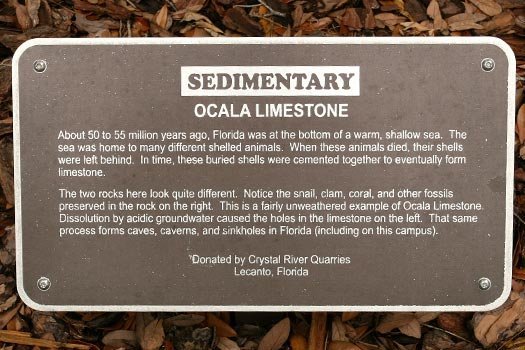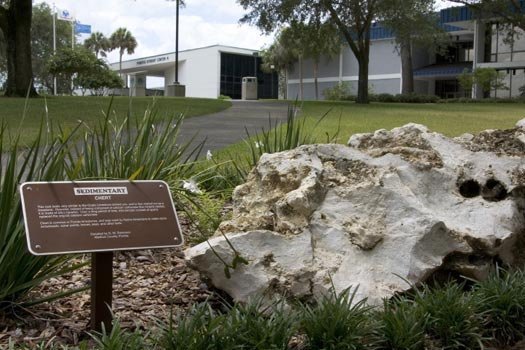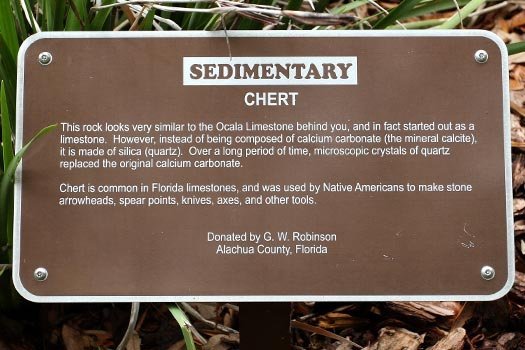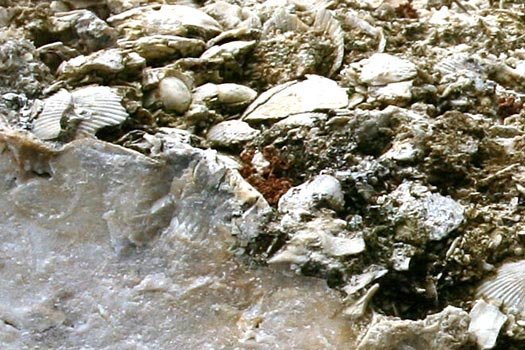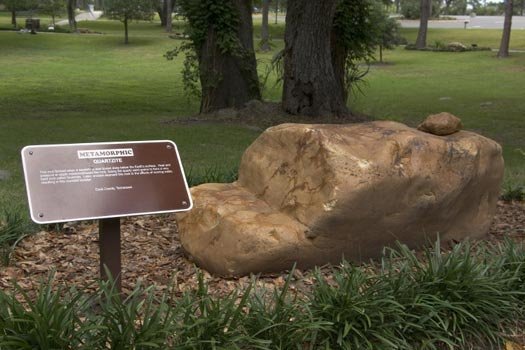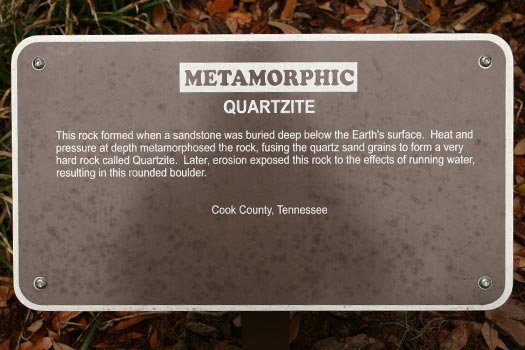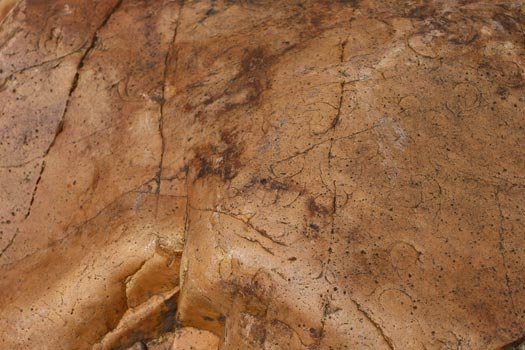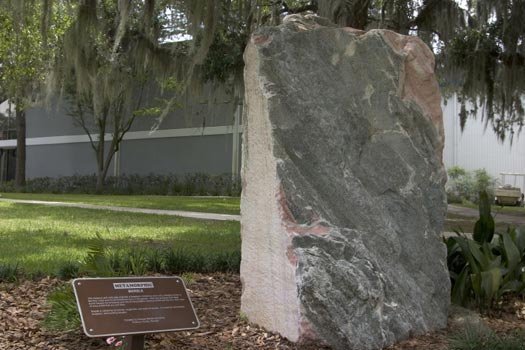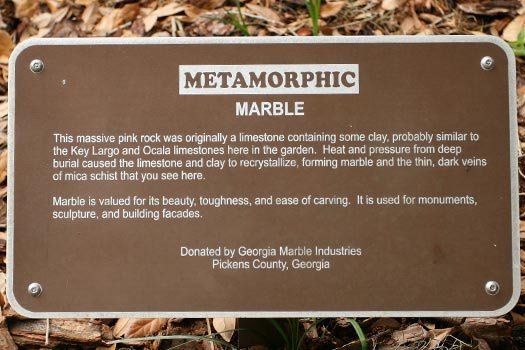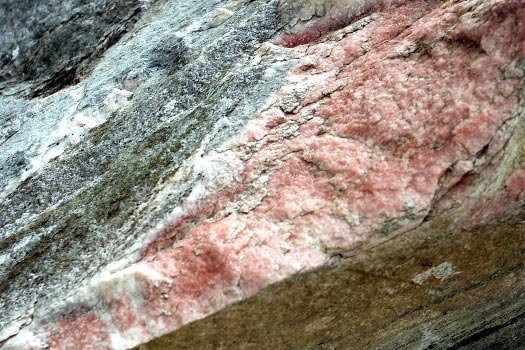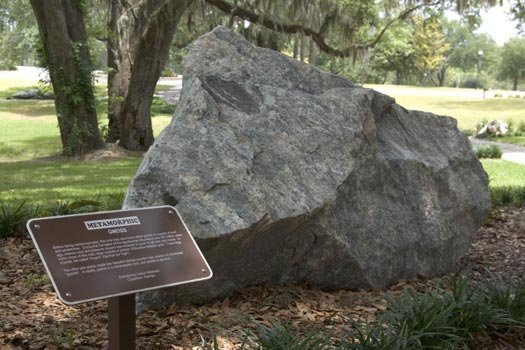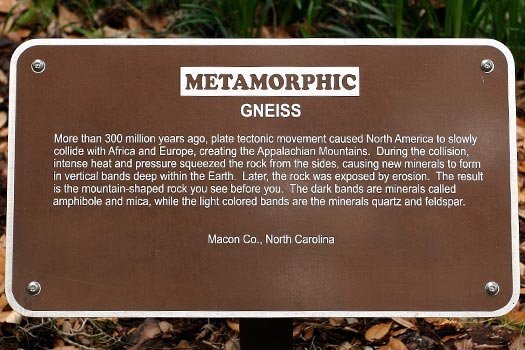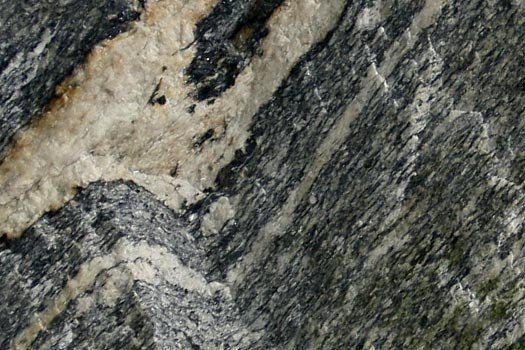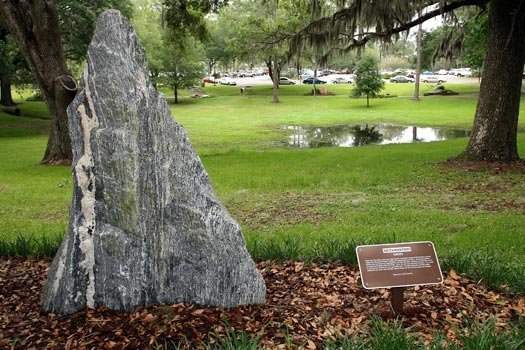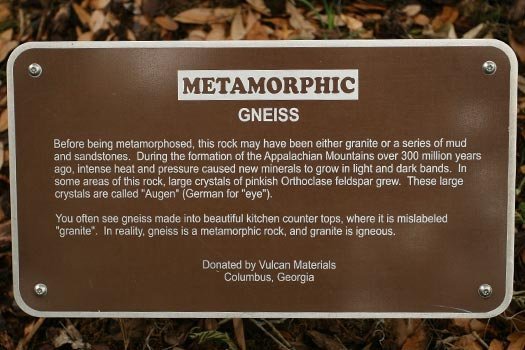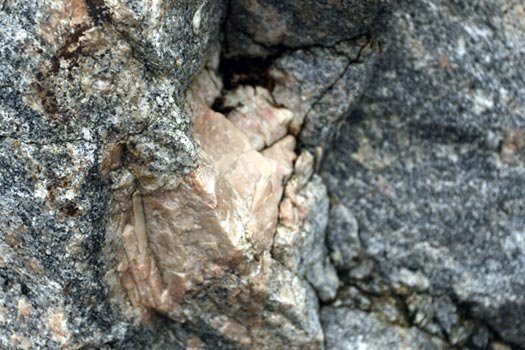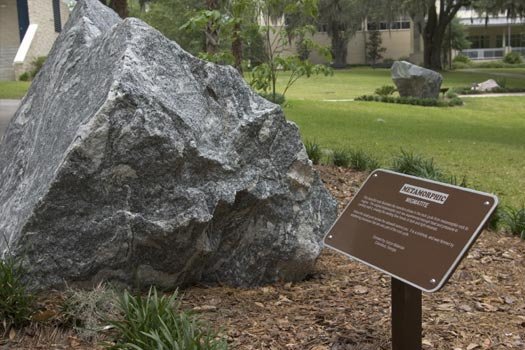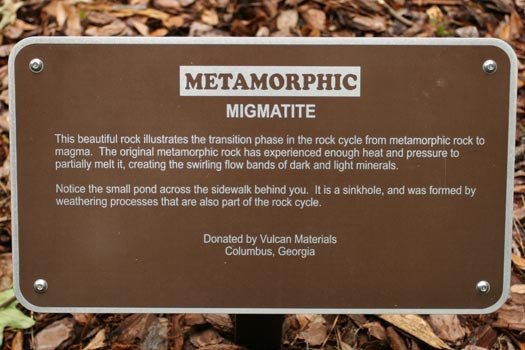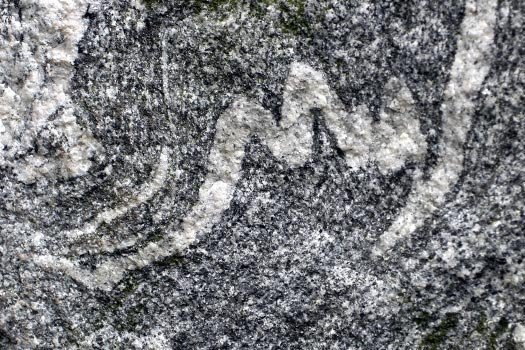Online Tour
On This Page
Igneous
Gabbro
At 5000 kg (11,000 lbs), this is the heavyweight of our collection. This type of igneous rock has large crystals formed by the slow cooling of magma (molten rock) deep underground. Its dark color indicates formation from magma rich in iron, magnesium and calcium. The light-colored veins of quartz, with pyrite (the yellow mineral), were forcefully injected at a later time. - Donated by Vulcan Materials Corp., Charlotte, North Carolina
Pegmatite
The term pegmatite is a textural term used to describe exceptionally coarse to gigantic-grained igneous rocks. Most pegmatites contain the same minerals as granite, but the crystals are much larger. Sometimes unusual and valuable minerals such as beryl (aquamarine), tourmaline, topaz, or gold are present as well. This pegmatite exhibits large crystals of the minerals quartz (grey or clear), feldspar (pink or salmon), and muscovite (sheets and flakes). - Fremont County, Colorado
Granite
Rocks are more than just pieces of the Earth's crust. They provide us with some of the raw materials that make our civilization possible: monuments, countertops, building stone, and even places to sit. This light colored, coarse textured granite from Western Georgia cooled slowly underground from magma rich in silica and aluminum, forming minerals such as quartz, feldspar, and mica. Granite is by far the most common rock found in the Earth's continental crust. - Donated by Vulcan Material Corp., Columbus, Georgia | Bench donated by Jana Col, Gainesville, Florida
Volcanic Glass
The large rock is obsidian (volcanic glass), which often forms in lava flows where cooling takes place so quickly that crystals do not have time to grow. Volcanic glass has no crystal structure and fractures in smooth conchoidal (curved) shapes. Obsidian was used by many native cultures to make tools, arrowheads, and weapons. The smaller boulder to the left is pumice, the hardened froth from a lava flow. The two boulders to the right are ash-fall tuffs formed as glassy, hot ash accumulated near a volcanic eruption. - Obsidian - Custer County, Colorado | Pumice & Ash-Fall Tuff - Mono County, California
Basalt
If we could view a piece of this boulder under a microscope we would see that it is composed of small, interlocking crystals. The fine texture and the dark color indicates rapid cooling of lava rich in iron, magnesium and calcium. This type of lava erupts in many locations worldwide, primarily in the oceans. The formation of the Appalachian Mountains caused the volcanic activity that created this rock. - Donated by Vulcan Materials Corp., Warrenton, Virginia
Sedimentary
Sandstone Bench
Conglomerate
One way to think about sedimentary rocks is to visualize the environment present while the sediments were deposited. Conglomerates consist of rounded, coarse-grained particles. Note the rounded quartz pebbles in this specimen. Where do we usually see pebbles such as these being concentrated today? The bottom of a swift-moving stream. Therefore, the presence of this type of rock in the Earth's crust indicates deposition in an ancient stream. - Marion County, Tennessee
This conglomerate boulder came from Alaska. It is a colorful, long-ago river bank that turned to stone. However, there were no land animals during the Silurian epoch, 420 million years ago. But there was life then and before, in the seas. Some of the pebbles that make up the conglomerate are marine limestones with fossils in them. Jean Klein loved Alaska! He was serving in the US Army in Alaska in 1964 when the Good Friday earthquake hit. Fred Olsen, who taught Geology with Jean here at Santa Fe College for over ten years, also loves Alaska. Jean and Fred spent several summers together in Alaska fishing, kayaking, and geologizing. - Bench donated by Fred Olsen and Debbie Baldwin, who met Jean in Geology Graduate School at the University of Florida
Sandstone
This rock is composed of sand-sized quartz grains. The distinctive red color comes from iron oxide that serves as the cement that binds the grains together. The sand grains in this rock were piled into layers of wind-blown sand in a desert region of what is now central Colorado. This rock formed in the Permian Period and is at least 250 million years old, predating the present day Rocky Mountains. - Larimer County, Colorado
This rock consists of cemented quartz sand grains. Note the undulating ripple marks "frozen" on the surface. These ripple marks indicate that the sand grains were deposited in a streambed with the direction of the current indicated by the shape of the ripple marks. This is an example of features within a sedimentary rock, such as these ripple marks, that help us understand the environment at the time the sediment was deposited. - Putnam County, Tennessee
Mudstone
Mudstones and thinner-bedded shales are similar to sandstones except the rock's individual grains are the size of silt and clay particles. Grains this small settle out only when water is very still. Mudstones and shales form as a result of the deposition of silt and clay (mud) under low energy conditions such as lagoons, estuaries, flood plains, and river deltas. Please feel free to sit and contemplate. - Donated by Jacobs Creek Stone, Denton County, North Carolina
Limestone
Coquina limestone is composed of whole and fragmented mollusk shells and sand grains cemented by calcite. Similar sediment is being deposited at Flagler Beach today. Notice the cylindrical hole in this specimen. It was created by wave action when the rock was exposed along the seashore on Florida's Atlantic Coast. Coquina has been used as a building stone in Florida for over 400 years. The Castillo de San Marcos in St. Augustine was built from coquina quarried from the Anastasia Formation. Excellent exposures occur at Washington Oaks State Park in Flagler County and Blowing Rocks Beach in Martin County, Florida. - Donated by Flagler Sand and Gravel, Bunnell, Florida
Limestone comes in many forms, but all are composed of the mineral calcite. Key Largo limestone from South Florida contains numerous fossil corals. It was a living coral reef less than 100,000 years ago. Key Largo limestone is exposed in the Florida Keys from Sand Key to Loggerhead Key, and is quarried to create canals and boat basins. Once quarried, this beautiful rock is often cut into tiles used as decorative stone. An excellent exposure can be seen at Windley Key State Geological Site in the Florida Keys. - Donated by Keystone Products, Florida City, Florida
Ocala Limestone
About 50 to 55 million years ago, Florida was at the bottom of a warm, shallow sea. The sea was home to many different shelled animals. When these animals died, their shells were left behind. In time, these buried shells were cemented together to eventually form limestone. The two rocks here look quite different. Notice the snail, clam, coral, and other fossils preserved in the rock on the right. This is a fairly unweathered example of Ocala Limestone. Dissolution by acidic groundwater caused the holes in the limestone on the left. That same process forms caves, caverns, and sinkholes in Florida (including on this campus). - Donated by Crystal River Quarries, Lecanto, Florida
Chert
This rock looks very similar to the Ocala Limestone behind you, and in fact started out as a limestone. However, instead of being composed of calcium carbonate (the mineral calcite), it is made of silica (quartz). Over a long period of time, microscopic crystals of quartz replaced the original calcium carbonate. Chert is common in Florida limestones, and was used by Native Americans to make stone arrowheads, spear points, knives, axes, and other tools. - Donated by G. W. Robinson, Alachua County, Florida
Metamorphic
Quartzite
This rock formed when a sandstone was buried deep below the Earth's surface. Heat and pressure at depth metamorphosed the rock, fusing the quartz sand grains to form a very hard rock called Quartzite. Later, erosion exposed this rock to the effects of running water, resulting in this rounded boulder. - Cook County, Tennessee
Marble
This massive pink rock was originally a limestone containing some clay, probably similar to the Key Largo and Ocala limestones here in the garden. Heat and pressure from deep burial caused the limestone and clay to recrystallize, forming marble and the thin, dark veins of mica schist that you see here. Marble is valued for its beauty, toughness, and ease of carving. It is used for monuments, sculpture, and building facades. - Donated by Georgia Marble Industries, Pickens County, Georgia
Gneiss
Before being metamorphosed, this rock may have been either granite or a series of mud and sandstones. During the formation of the Appalachian Mountains over 300 million years ago, intense heat and pressure caused new minerals to grow in light and dark bands. In some areas of this rock, large crystals of pinkish Orthoclase feldspar grew. These large crystals are called "Augen" (German for "eye"). You often see gneiss made into beautiful kitchen counter tops, where it is mislabeled "granite". In reality, gneiss is a metamorphic rock, and granite is igneous. - Donated by Vulcan Materials, Columbus, Georgia
More than 300 million years ago, plate tectonic movement caused North America to slowly collide with Africa and Europe, creating the Appalachian Mountains. During the collision, intense heat and pressure squeezed the rock from the sides, causing new minerals to form in vertical bands deep within the Earth. Later, the rock was exposed by erosion. The result is the mountain-shaped rock you see before you. The dark bands are minerals called amphibole and mica, while the light-colored bands are the minerals quartz and feldspar. - Macon Co., North Carolina
Migmatite
This beautiful rock illustrates the transition phase in the rock cycle from metamorphic rock to magma. The original metamorphic rock has experienced enough heat and pressure to partially melt it, creating the swirling flow bands of dark and light minerals. Notice the small pond across the sidewalk behind you. It is a sinkhole, and was formed by weathering processes that are also part of the rock cycle. - Donated by Vulcan Materials, Columbus, Georgia
